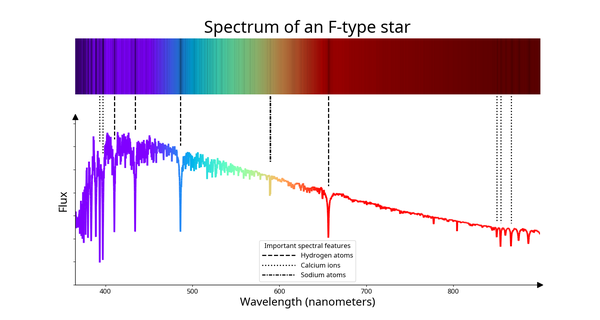This page describes an image Spectrum of an F-type star
Download PDF File (PDF file 74.72 kB)
Diagram caption:
The spectrum of the F-type star 2MASS J22243289+4937443. The colour of the line between 400 nm and 700 nm roughly corresponds to the colour the human eye would see light of that wavelength. Below 400 nm and above 700 nm, where the human eye can see little to no light, the lines are coloured blue and red respectively.
The black lines show spectral absorption lines caused by atoms and ions of different elements in the star’s atmosphere. These atoms and ions absorb at specific wavelengths, causing sharp, dark lines in the spectra. How strong these lines are depends on the temperature of the star’s atmosphere. Two stars made from the same mix of elements could have spectra with vastly different sets of lines in their spectra if they have different temperatures in their atmospheres. The lines from hydrogen atoms that are strongest in A-type stars are still relatively strong in F-type stars but lines from metals, particularly ionised calcium begin to become strong at this spectral type.
Diagram credit: IAU OAE/SDSS/Niall Deacon.
Diagram translation status: Not yet approved by a reviewer
Related glossary terms:
F-type Star
, Spectrum
, Wavelength
Categories:
Stars
Created with support from: OAE Main Office Main Office
Diagram license: Creative Commons অ্যাট্রিবিউশন 4.0 আন্তর্জাতিক (CC BY 4.0) Creative Commons অ্যাট্রিবিউশন 4.0 আন্তর্জাতিক (CC BY 4.0) icons
Want to make your own version of this diagram? Then have a look at the code that
produced this diagram on Github
Linked Diagrams
Spectrum of an O-type starSpectrum of a B-type star
Spectrum of an A-type star
Spectrum of a G-type star
Spectrum of a K-type star
Spectrum of an M-type star
Stellar spectral types
Stellar spectral types - bands
In Other Languages
ইংলিশ: Spectrum of an F-type starইটালিয়ান: Spettro di una stella di tipo F
ফ্রেঞ্চ: Spectre d'une étoile de type F
স্প্যানিশ: Espectro de una estrella tipo F
আরবী: طيف نجم من النوع F
Want to create your own translation? Then have a look at the code that produced this diagram on Github
The diagram captions presented on the OAE website were written, translated and reviewed by a collective effort from the OAE, the OAE Centers and Nodes, the OAE National Astronomy Education Coordinators (NAECs) and other volunteers. You can find a full list of credits for our translation project here. All media file captions are released under a Creative Commons CC BY-4.0 license and should be credited to "IAU OAE". The media files themselves may have different licenses (see above) and should be credited as listed above under "credit".









